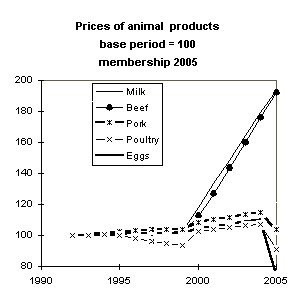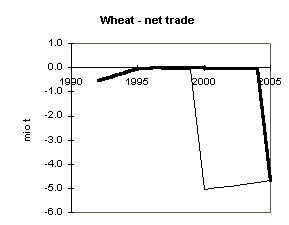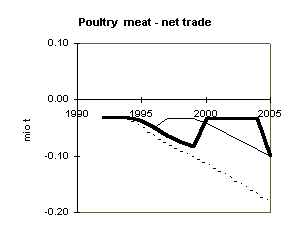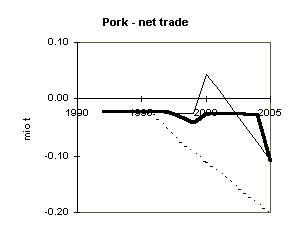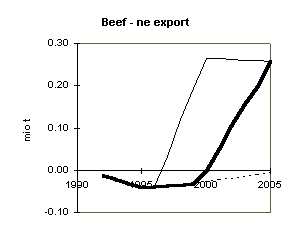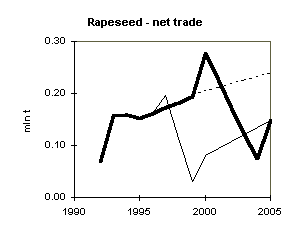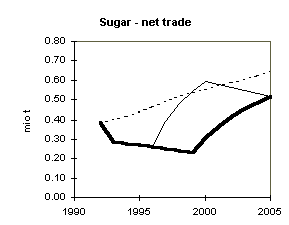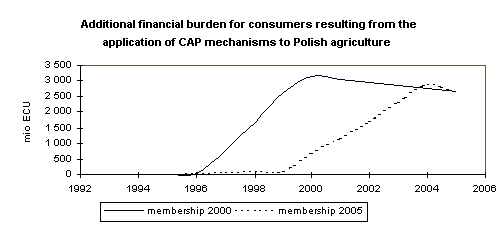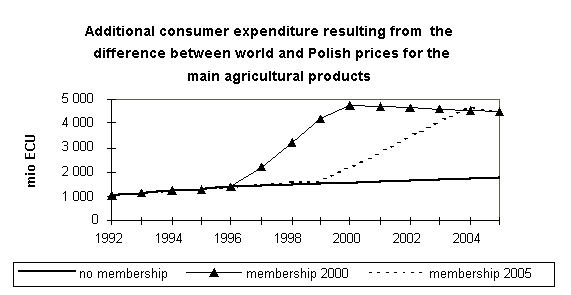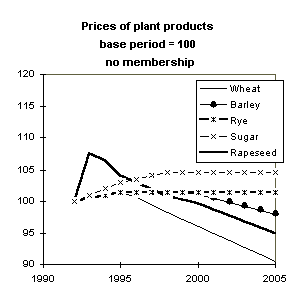
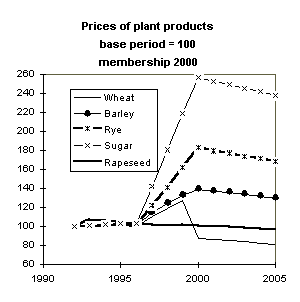
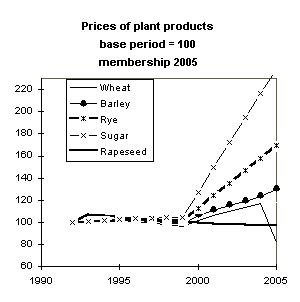
SCENARIOS FOR INTEGRATION OF POLISH
AGRICULTURE WITH THE EUROPEAN UNION
W_adys_aw Piskorz and Jerzy Plewa
Ministry of Agriculture and Food Economy
Warsaw, Poland
INTRODUCTION
Accession of the Central and East
European countries (CEE) to the European Union (EU) is likely
to constitute one of the greatest challenges to be faced by both
the EU and CEE in a few years' time. Agriculture is one of the
sectors in which structural adjustments will be most necessary,
and at the same time may bring about substantial benefits to both
sides. To this end are indispensable detailed preparations and
comprehensive efforts that would enable solving numerous problems
at the adjustment stage. The absence of foresight and preemptive
actions in the agricultural and food sector may complicate and
greatly delay the integration processes. Poland's integration
with the European Union and full EU membership constitute a strategic
objective and top priority for Polish foreign and economic policies.
Poland formally applied for EU membership in April 1994. Efforts
- aimed at developing an appropriate integration strategy - have
been continuing on many planes political, economic and social.
However, integration cannot be implemented without settling the
issues of agriculture, food economy and Polish rural environment.
The experiences of the EU countries suggest that the solution
of key problems of integration depends to a large degree on agriculture.
One of the most frequently mentioned,
and at the same time controversial barriers to the application
of the extensive array of CAP instruments to agriculture in Poland
and other associated countries are the estimated high costs for
the EU budget. The budget costs of the CAP has already provoked
significant changes in both the "Own Resources" mechanism
of the EU (the 1980s budget crises), and in the CAP itself (the
MacSharry reforms).
Reliable and comprehensive analyses
concerning the integration of CEE with EU, and especially their
agricultural sectors, are of key importance for the development
of appropriate integration strategies. The enormous role to be
played by detailed analyses and studies of integration processes
is appreciated by the European Commission, and is ever more clearly
perceived by the acceding countries. In the case of Poland, this
is manifested by a great number of studies and analyses, performed
by various centers, commissioned and financed by the Ministry
of Agriculture, Foundation for Assistance Programs for Agriculture,
Council of Ministers (Office of the Government Plenipotentiary
for Integration), Parliamentary committees, and others.
DESCRIPTION OF THE MODEL
Simulations have been carried out
using the ESIM (European Simulation Model) model, developed by
Professors Tangermann and Josling and their co-workers for ERS
USDA (Economic Research Service of the United States Department
of Agriculture). ESIM is a partial equilibrium model facilitating
quantitative studies (basing on demand and supply analysis). It
allows for simulating different variants of agricultural policies
worldwide broken down into country blocs, including EFTA, EU,
Poland, Czech Republic, Hungary, Slovakia and the USA. The remaining
countries have been divided into three groups: centrally planned
economies, other industrialized countries, and developing countries.
Agricultural sectors of individual countries have been disaggregated
to 26 agricultural and food products; these are mostly agricultural
raw materials and several processed products.
Table 1: Products included in the
model.
| Name of product | |
| vegetable products | wheat (common), durum wheat, barley, maize, other cereals, soybean, rapeseed, sunflowerseed,
Soybean, sunflower, rapeseed meal, cake and oil, sugar, manioc, maize gluten feeds, protein feeds, other energy feeds. |
| animal products | milk, skimmed milk powder, butter, cheese, beef, pork, poultry, eggs |
ESIM is a partial equilibrium model,
which means that in individual agricultural markets equilibrium
is reached by finding a world market clearing price. The differential
between domestic and world prices depends on the instruments of
agricultural and trade policy applied. Therefore, price policy
and border measures restrict the movements of domestic prices.
Both producers and consumers function under the conditions imposed
by agricultural policy. Supply, consumer and feed demand respond
to changes in productivity, income, and primarily to price changes.
ESIM features a general structure of cross price elasticities
relating especially to production and feed demand, which allow
for the analysis of substitution effects.
Pricing policies and border instruments
applied in the model are similar to the actual regulations prevailing
in the analyzed countries, especially in the European Union. The
majority of dramatic changes in the pattern of consumption and
production in Poland took place in 1989-1991; therefore, the base
period adopted for the Vysehrad group countries (1991-1993 average)
provides a good reference for long-term predictions. Assumptions
concerning further structural changes in demand and production
may be easily introduced to the analyzed scenarios. This makes
the ESIM model an efficient tool for examining the effects of
pursuing different agricultural policies, in particular with reference
to the processes of integration with the European Union.
SIMULATION OF ASSUMPTIONS
Results of the analysis of various
integration scenarios presented further on in this report are
based on the a common assumption relating to the Common Agricultural
Policy and its evolution. Controlled support prices and other
regulations by the EU Council of Ministers until the completion
of the MacSharry reform (1996) are introduced in to the model.
For the 1996-2005 period it has been assumed that both regulated
prices and compensatory payments will be phased down at the rate
of 1 % annually in real terms, whereas other regulations, such
as the level of set-aside, will not be changed.
Institutional regulatory instruments
have been applied in all scenarios of Poland's integration with
the EU aimed at ensuring the necessary agricultural adjustments
of the Vysehrad group to the CAP rules.
In all scenarios analyzed identical
assumptions have been made as regards the time schedule of integration,
adjustment period and production quotas for all Vysehrad group
countries (Poland, Hungary, Czech Republic and Slovakia).
SIMULATION RESULTS
The simulation analysis based on the
ESIM model yields time series estimates (years 1994 - 2005) of
the following variables characterizing the situation of the agricultural
and food sector:
×
market prices (domestic prices, world prices, prices in the EU
and other countries)
×
output level of primary food and agricultural products
×
volume of foreign trade
×
balances of domestic agricultural and food products
×
Farmers' incomes from individual types of agricultural production
×
expected expenditures from the EU budget to cover the cost of
export subsidies and compensatory payments
The model calculates the above variables
for all countries and groupings analyzed. In Annex selected results
of simulation for three basic scenarios are presented:
i) without integration (base scenario)
ii) EU membership in 2000 with the beginning of adjustments in 1997
iii) EU membership in 2005 with the
beginning of adjustments in 2000 are presented below.
Due to the number of simplifying assumptions
adopted in the model, the presented results should be treated
with considerable caution and considered to outline trends rather
than precisely determined numerical values.
CONCLUSIONS
Estimates of the costs of integration
of Polish agriculture presented in this paper are based on specific
assumptions concerning Common Agricultural Policy, productivity
changes, world prices etc. Changes in one or all of those parameters
may substantially change the result of estimates. Because of
above limitations this study should be treated as an approach
to identify the challenges of integration rather than to precisely
quantify the costs and benefits of the integration.
The calculations have revealed potentially
serious changes in the level of prices for certain agricultural
products upon integration with the EU. This is a result of the
existing considerable price differential between Poland and the
EU. Each of the integration variants provides for radical changes
in the level of prices for numerous agricultural products (sugar,
milk and beef prices, a substantial increase in rye prices, and
stagnation or decline of prices for wheat, rapeseed, poultry,
eggs and pork).
The simulation results do not confirm
fears concerning a potentially substantial growth of agricultural
output in Poland following the application of CAP mechanisms.
There will be a certain increase in the output of products which
enjoy greatest support under CAP (e.g. beef). The forecast level
of cereal production may be lower in EU membership variants than
without membership. Relatively attractive sugar prices would stimulate
substantial growth of production - if not for the quotas, which
would undoubtedly become binding for Polish farmers upon accession
to the Union. Given the existence of quotas, no major changes
in the level of sugar production and export from Poland should
be expected. Both positive and negative changes in business conditions
generate a relatively weak response of the atomized Polish agriculture.
This is confirmed by e.g. a relatively smaller decline of agricultural
output in Poland as compared with other post-communist countries
during the first years of the transformation. The example of such
countries as Greece, Spain, or Portugal, which did not experience
any rapid growth of production upon their accession to the Union,
also confirms this thesis.
A more substantial growth of output
after Poland's accession to the EU may be expected only in certain
areas of livestock production. This is true especially with regard
to beef, and to a lesser degree poultry and pork. A marked increase
of milk prices will not generate a rapid growth of output because
of milk quotas operating in the Union. The quota arrangements
will probably remain in place at the time of Poland's joining
the Union. The level of both sugar and milk quotas in Poland
will be subject to negotiations.
The integration of Polish agriculture
with the EU should not essentially change position of Poland
in agricultural and food trade, but results of the simulation
analysis point to a potential growth of net export of beef. This
may not be possible at the estimated scale when the EU will further
adjust CAP (as a result of WTO requirements). As regards poultry
and pork integration with the Union will reduce the volume of
necessary import. On the other hand, Polish exports of rapeseed
and sugar may decline.
The ESIM model does not take into
account the restrictions imposed as an aftermath of the Uruguay
Round of the GATT concerning subsidized export volumes and the
amount of export subsidies. For several products the modeled export
level substantially exceeds the permissible level of subsidized
exports - e.g. sugar, beef, cereals. In such cases, before accession
to the Union, Poland could export the surpluses at world prices.
In certain cases (e.g. rapeseed), the situation is the reverse.
GATT restrictions will modify the actual export level.
The analysis shows that the main budgetary
implication of the application of CAP mechanisms to Polish agriculture
will be an increase of compensatory payments by about 1.6 billion
ECU. The cost of export subsidies will be at a relatively low
level - about 500-800 mln ECU. It was assumed that Polish farmers
will enjoy access to payments and subsidies (including compensatory
payments) on a par with their counterparts from other EU countries.
Only budgetary expenditure relative to export subsidies and compensatory
payments have been taken into account in the calculations. This
does not exhaust all the potential budgetary expenditures on the
application of CAP mechanisms to Polish agriculture. Account should
be made of additional 400-500 mln ECU for intervention purchases
of goods included in the model (taking the existing structure
of FEOGA Fund spending as the basis). Adopting assumptions similar
to those in Prof. S. Tangermann's report (the share of budgetary
spending on products not included in the model amounts to 40%
of total FEOGA expenditures) some 0.7 - 0.8 billion ECU should
be added to the amount of budgetary expenditures.
Total budgetary expenditure relative
to the application of CAP mechanisms to Polish agriculture may
be estimated at 3,230 - 3,690 mio ECU. This follows from the
following items:
× export subsidies 560 - 800
× compensatory payments 1470 - 1590
×
other costs not accounted for in the model 1100 - 1300
Estimating the overall financial implications
of Poland's membership in the EU it is necessary to consider EU
structural funds, which constitute a major item. Their share in
the overall EU budget reaches over 40 %. They are not treated
as expenditures on common agricultural policy. A portion of structural
funds (objectives 5a and 5b) is used for supporting the agricultural
and rural sector. As a country with a relatively low per capita
GDP level Poland qualifies for structural assistance. The estimated
amounts that would be appropriated for Poland vary, ranging from
3 to 15 billion ECU (estimates closer to 3 billion ECU are more
realistic). The problem of EU structural funds in the light of
Poland's accession to the Union is a subject of a separate study
prepared by a SAEPR team
The value of the basket of agricultural
and food products for Polish consumers at domestic (real) prices
exceeds its value at world prices by about 1 billion ECU. In
turn, this value at integration scenario prices exceeds the value
at no integration scenario prices by about 3 billion ECU. The
additional burden for consumers as an effect of the application
of CAP mechanisms to Polish agriculture slightly exceeds the approximate
additional amount that could be obtained from the budget by the
agricultural sector in export subsidies and compensatory payments.
The adoption of CAP mechanisms would
mean that for each additional ECU obtained by Polish farmers from
the EU budget Polish consumers would have to spend additional
2 ECU for food. If, as suggested by West European economists,
compensatory payments were not available for Polish farmers, the
ratio may be as 1:5.
It is important to answer the question
as to which of the integration variants would be most beneficial
for Poland. There are many factors conditioning this answer, which
are at present difficult to estimate. In particular, there is
no certainty as regards the further evolution of the Common Agricultural
Policy, the availability of compensatory payments for Polish farmers,
or the determination of quotas. Both EU membership scenarios provide
for a substantial growth of prices for a majority of agricultural
and food products. The volume of output changes at a varying degree.
The effect of integration on foreign trade is more ambiguous (increase
or decrease of exports in various commodity groups).
Each variant providing for agricultural
price adjustments before joining the EU structures involves enormous
burdens for the Polish budget as regards payments to farmers,
as well as higher food prices for consumers, without simultaneous
access to payments from the EU budget. Both variants will in effect
generate similar levels of prices and output; the variant providing
for later integration will result in slightly lower agricultural
prices (as a consequence of a lower price level in the Union).
The analysis of budgetary costs throughout
the adjustment period shows that these costs increase alongside
the lengthening of the price adjustment period. Simulation results
have confirmed that from the Polish viewpoint the most beneficial
scenario would be the starting of agricultural price adjustment
after the accession to the Union.
Sensitivity analysis of the model,
limited to different rates of productivity growth in Polish agriculture,
only slightly modifies the results as compared with the level
of productivity used as reference.
The analysis of even this preliminary simulation results of various EU integration scenarios already allows for identifying certain solutions that may alleviate the fears entertained equally by the Union and Poland as regards this process. The estimated level of budgetary expenditures and transfers from Polish consumers as a consequence of adjustments to CAP favors the recommendation of fast accession scenarios with a several year adjustment period for the agricultural sector under EU membership. Such a solution allows for certain costs of adjustments to be taken over by the EU budget (to which Poland will contribute about 1.5 billion ECU according to SAEPR estimates). Nevertheless, certain costs of adjustments will be shifted onto Polish consumers, who will pay higher prices for food products. Comparing two fast accession scenarios, that providing for full membership in 2000 with an adjustment period for Polish agriculture until 2005 seems to be more realistic. The scenario interpreted as membership in 1997 and a transition period until 2000 seems overly optimistic and unrealistic for political reasons. The recommended scenario, which provides for full membership in 2000 (and the adjustment period for agriculture until 2005), reveals many similarities to the EU accession experiences of such countries as Spain, Portugal, Greece.
ANNEX :
Prices
of selected agricultural products in different integration scenarios

